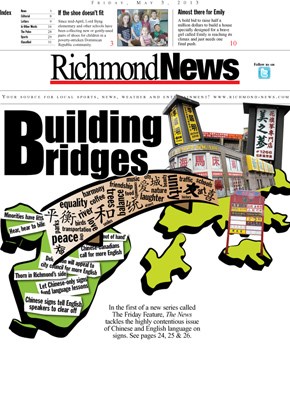Back in March, the City of Richmond sidestepped the issue of language used on business signs and literature after being presented with a 1,000-strong signature from concerned residents. The News, deciding to do its own investigation, reached out to people in the Chinese business community, to find out what they think, what their concerns are and if they think theres even an issue at all.We also recruited the help of Richmonds Hong Kong-born city councillor, Chak Au, who was the lone voice on council when it came to building bridges across an apparent cultural divide.Watch out for next weeks News for more on building bridges.---------------------------------------------------
I dont speak Mandarin or Cantonese and some would suggest I can barely speak English at times.
So, when the News decided to spend a day on foot, scouring Richmonds famous Golden Village, in a bid to dig under the surface of the Chinese business community we enlisted the help of Chak Au, our Hong Kong-born city councillor, whos been trying for years to build bridges between the Chinese and English-speaking communities.
The Golden Village, or Golden Triangle as its also known, is a largely commercial district with a high concentration of Asian-themed shopping malls and is the home to the second-largest Asian community in North America.
For those who rarely venture north of Westminster Highway, the Triangles borders are Sea Island Way to the north, Garden City Road to the east, Alderbridge Way to the south and about 300 metres west of No. 3 Road to the west.
As we ventured north on Hazelbridge Way towards the first of our strip mall stops, Union Square, we asked Au why there appeared to be less and less English on signs and literature the further in we went.
Its almost purely for business reasons because they only want to target certain customers, said Au, as we walked toward the giant yellow and black Chinese language characters on the sidewall of Union Square.
It is a very small percentage, though, that only have Chinese; only about one per cent of all businesses I would say.
What I think is an issue with some people is the proportion of Chinese to English. Look at that (Union Square yellow and black signage) for example.
Thats all you see from about a mile away.
As we toured Union Square itself, the Chinese language was not surprisingly predominant, especially given the 60 per cent Asian population in Richmond.
But most, if not all, had at least a little English on their signs, windows, menus and sandwich boards.
And there were even four or five that had no Chinese at all. A Taiwanese-owned beauty salon, JJ Fantasy World, for example, has been open for ten months, with 90 per cent of customers being Chinese, according to its staff.
The Hair Show, again, all English from the outside.
Further to the east, Continental Centre, and to the south, Pacific Plaza, both had about the same proportion of Chinese to English as Union Square; about 70/30 per cent would be an educated guess.
Most of the malls we visited had the odd one or two that struggled to display any English at all.
Both the small number of businesses with no English language and the unexpected scattering of shops with no Chinese caught Au himself by surprise.
But why should they use English at all, if their core customer is Asian or is of Asian descent?
This is what I think is the danger, said Au.
The Chinese-only market is big enough here that they dont need to rely on the English-speaking market.
If this is left alone, I think it will lead to a fractured community, because if people feel unwanted, they wont come here at all or wont come back if trying it out.
That is my fear and thats why I think its so important to bring the two communities together.
Au did, however, concede that it takes a lot of time and effort for such businesses to break into the non-Chinese market and for not too much in return, depending on what product or service theyre selling.
What then is the solution, if, indeed, one is needed at all?
Racial harmony is one of my goals, but people in those Chinese businesses in question need to be more respectful and sensitive to the larger community, said Au, Even though the English-speaking people might not be their target customer.
But this is only the surface; we need to communicate with each other better and understand each other better.
Some Chinese businesses, suggested, Au, dont realize they have a greater responsibility and they actually have a role to play in building bridges across different cultures.
I believe that when, just a few of them realize this, they make take that opportunity and that could be the start of the bridges being built?



